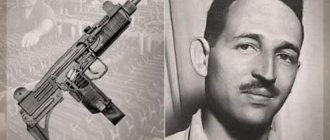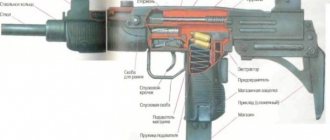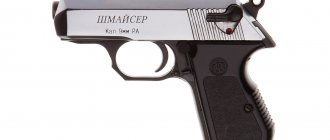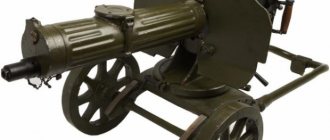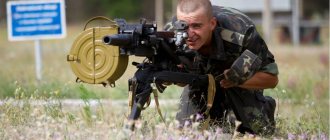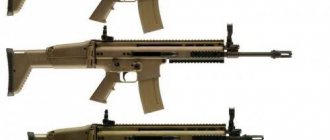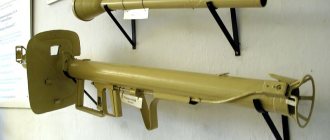Degtyarev submachine gun (PPD)
At the end of 1929, the Revolutionary Military Council decided that the submachine gun, which it assessed as a “powerful automatic close-combat weapon,” would in the near future be introduced into the Red Army’s weapons system. According to the decision of the Revolutionary Military Council, the main weapon of the Soviet infantry was to be a modern self-loading rifle, and an auxiliary weapon, along with it, was a submachine gun. Also in 1929, the first experimental 7.62 mm Degtyarev submachine gun was assembled. It is worth noting that earlier Degtyarev also won another arms competition with his Degtyarev machine gun.
In June-July 1930, a commission headed by division chief V.F. Grushetsky conducted tests of self-loading pistols and experimental submachine guns for new cartridges at the Scientific Testing Weapons Range (“Competition of 1930”). The results of these tests turned out to be generally unsatisfactory, so none of the samples presented for it was accepted for service. Nevertheless, the competition helped to finally determine the requirements for a new type of weapon.
PPD - photo
In 1931, the next version of the Degtyarev submachine gun appeared, with a semi-free bolt of a different type, in which slowing down the bolt's retreat was achieved not by redistributing energy between its two parts, but due to increased friction arising between the cocking handle of the bolt and the bevel in the front part of the cutout under it in the receiver, into which the handle fell after the bolt came to the extreme forward position, while the bolt itself rotated to the right at a small angle. This sample had a round receiver, more technologically advanced, and a barrel almost completely covered with wooden linings (instead of a casing).
Finally, in 1932, an even more simplified version appeared, this time with a blowback shutter. In 1932-1933, a total of 14 samples of 7.62 mm submachine guns were developed and field tested. The Degtyarev and Tokarev systems were considered the most successful, but the PPD turned out to be a little more technologically advanced and had a relatively low rate of fire, which was advantageous for this type of weapon.
PPD
After finalization, the PPD was approved by the GAU as a model for the production of a pilot batch (30 copies), and on July 9, 1935, it was adopted by the Red Army under the name “7.62-mm submachine gun model 1934 of the Degtyarev system (PPD).” In the same year, production began at Kovrov Plant No. 2.
The Degtyarev submachine gun model 1934 (PPD-34) is the first weapon of this type adopted by the Red Army. Its path from the creation of the first prototype to mass production dragged on for several years.
PPD-34 with barrel casing
One of the PPD-34 options involved eliminating the barrel casing, which resulted in a slight reduction in the weight of the structure. If this option had been approved, all submachine guns developed in the USSR later could have had a different appearance. The famous weapon of Victory - the Shpagin PPSh-41 submachine gun - would also most likely have had a different, less recognizable appearance.
Of the two PPDs tested (with a casing and without a casing), NIOP Polygon considered it more appropriate to focus on the sample with a casing as it represents the greatest ease of use (carrying over the shoulders, better protects the shooter from accidental burns). Moreover, from a production point of view, the absence of a casing does not provide any particular advantages.”
PPD-34 magazine neck
Most military experts of that time, both in the USSR and abroad, considered the submachine gun as a “police” weapon, and when used by the army, it was a purely auxiliary weapon. In accordance with these ideas, and also due to the rather low manufacturability and lack of development of the model itself in mass production, it was initially produced in small batches and entered mainly into service with the command staff of the Red Army as a replacement for revolvers and self-loading pistols (at about the same time, the rank and file began to be rearmed with another type automatic weapons - automatic and self-loading rifles). In 1934, Kovrov Plant No. 2 produced 44 copies of PPD, in 1935 - only 23, in 1936 - 911, in 1937 - 1,291, in 1938 - 1,115, in 1939 - 1,700 , in total - just over 5,000 copies.
Serial PPD-34 produced in 1936, fuse visible
Attitudes towards submachine guns changed dramatically during the Soviet-Finnish War of 1939–1940. Impressed by the actions of Finnish submachine gunners armed with Suomi submachine guns, the Red Army command not only used all the PPD-34 submachine guns stored in warehouses and Fedorov submachine guns manufactured back in the 20s, but also organized the delivery by plane to the front of submachine guns available at the border guards. The production of submachine guns was transferred to three-shift work with full use of all equipment.
Red Army soldier with PPD-34
Improvements in weapon design continued. On February 15, 1940, Degtyarev presented a modernized sample of the PPD, developed with the participation of the designers of the Kovrov plant S. N. Kalygin, P. E. Ivanov, N. N. Lopukhovsky, E. K. Aleksandrovich and V. A. Vvedensky.
This version was approved for production on February 21, 1940 by the Defense Committee of the Council of People's Commissars and adopted for service as the “1940 model submachine gun of the Degtyarev system.” Its release began in March of the same year. In total, 81,118 PPDs were produced in 1940, making its 1940 modification the most widespread. The army received significant quantities of this type of weapon.
PPD - photo
The PPD was produced at the beginning of World War II, but already at the end of 1941 it was replaced by the more advanced, reliable and much more technologically advanced Shpagin submachine gun, the development of which began in parallel with the deployment of mass production of the PPD in 1940. PPSh was initially designed for the possibility of production at any industrial enterprise with low-power pressing equipment, which turned out to be very useful during the Great Patriotic War.
Degtyarev submachine gun (PPD)
Meanwhile, the production of PPD in the initial period of the war was temporarily restored in Leningrad at the Sestroretsk Tool Plant named after S.P. Voskov and, from December 1941, at the plant named after. A. A. Kulakova. In addition, at the Kovrov plant in the pilot workshop, about 5,000 more PPDs were manually assembled from existing parts. In total, in 1941-1942, 42,870 PPDs were produced in Leningrad - the so-called “siege issue”, “blockade survivors”, they went into service with the troops of the Leningrad and Karelian fronts.
Subsequently, at the same production facilities, the production of a more advanced and technologically advanced Sudaev submachine gun was carried out.
Design and principle of operation
The submachine gun operates on the basis of automatic blowback action. The barrel bore is locked by the mass of the bolt, which is spring-loaded by a return spring. Shooting is carried out from the rear sear. The trigger mechanism ensures single and continuous fire. To switch the fire mode, the trigger mechanism has a corresponding translator, made in the form of a flag located in front of the trigger guard. On one side of the flag there is the number “1” or the inscription “one” - for single shooting, on the other - the number “71” or the inscription “continuous.” - for firing with automatic fire.
Degtyarev submachine gun
During most of the PPD release, the cartridge primer was broken by a striker-type striker-type impact mechanism installed separately in the bolt; the striker was fired after the bolt came to the extreme forward position.
The fuse in the form of a slider is located on the bolt handle. When the safety is engaged, its tooth engages with the cutout of the receiver, blocking the bolt.
The receiver with the barrel casing is made of a piece of pipe in which the barrel is mounted on two fixed liners. Perforated casing. The 1940 model stock is split to accommodate a disc magazine that does not have a neck.
Degtyarev submachine gun disassembled
The submachine gun has a sector sight with graduations up to 500 m, a late-release 1940 model has a sight with a reversible rear sight, designed for firing at a range of up to 100 and up to 200 m.
Each submachine gun was supplied with an accessory consisting of: a cleaning rod with a handle and two links with rubbing, a screwdriver, a drift, a brush, an oiler with two compartments - for lubricating oil and an alkaline composition for cleaning barrels.
History of creation
Submachine guns appeared during the First World War. This weapon was supposed to significantly increase the firepower of the infantry, making it possible to break the “positional deadlock” of trench warfare. By that time, machine guns had proven themselves to be very effective defensive weapons, capable of stopping any enemy attack. However, they were clearly not suitable for offensive operations. PMV machine guns had a very respectable weight and were mostly mounted. For example, the well-known Maxim machine gun weighed more than 20 kg (without water, cartridges and the machine), and together with the machine - more than 65 kg. Machine guns of the First World War had a crew of two to six people.
It is not surprising that the idea of arming infantry with light, rapid-fire weapons that could be easily carried and used by one person soon appeared. It led to the emergence of three types of automatic weapons at once: an automatic rifle, a light machine gun and a submachine gun, which uses pistol cartridges for firing.
The first submachine gun appeared in Italy in 1915. Later, other countries participating in the conflict took up similar developments. Submachine guns did not have a big impact on the course of WWII, however, the design developments made during this period were used to create a number of successful examples of these weapons.
In the USSR, work on the creation of new submachine guns began in the mid-20s. Initially, they planned to equip junior and mid-level officers with them, replacing pistols and revolvers. However, the attitude of the Soviet military leadership towards these weapons was somewhat dismissive. Due to their low tactical and technical characteristics, submachine guns were considered “police” weapons; the pistol cartridge had low power and was effective only in close combat.
In 1926, the Artillery Directorate of the Red Army approved the technical requirements for submachine guns. The ammunition for the new type of weapon was not immediately chosen. Initially, it was planned to produce submachine guns chambered for the 7.62x38 mm Nagant cartridge, but later preference was given to the 7.63x25 mm Mauser cartridge, which was actively used in the Red Army's weapons system.
In 1930, testing of prototypes of the first Soviet submachine guns began. Tokarev (chambered 7.62×38 mm Nagant) and Degtyarev and Korovin (chambered Mauser) presented their developments. The leadership of the Red Army rejected all three samples. The reason for this was the unsatisfactory tactical and technical characteristics of the presented weapons: the low weight of the samples, together with the high rate of fire, gave a very low accuracy of fire.
Over the next few years, more than ten new types of submachine guns were tested. Almost all famous Soviet weapons designers worked on this topic. The submachine gun created by Degtyarev was recognized as the best.
This weapon had a relatively low rate of fire, which had a positive effect on its accuracy and accuracy. In addition, Degtyarev’s submachine gun was much cheaper and more technologically advanced than competitors’ samples. The future PPD had a large number of cylindrical parts (receiver, barrel casing, butt plate), which could be easily manufactured on conventional lathes.
After some modification, the Degtyarev submachine gun was put into service on June 9, 1935. First of all, they planned to arm the junior command staff of the Red Army with it as a replacement for revolvers and self-loading pistols. Serial production of weapons began at the Kovrov plant No. 2.
However, over the next few years, the production of PPD proceeded, to put it mildly, slowly: in 1935, only 23 weapons were manufactured, and in 1935 - 911 units. Until 1940, a little more than 5 thousand units of PPD rolled off the assembly line. For comparison: only in 1937-1938. More than 3 million repeating rifles were produced. From this it is clear that the Degtyarev submachine gun remained for a long time for the Soviet army and industry, in fact, a kind of curiosity and a prototype on which the production technology and tactics of using new weapons were tested.
Taking into account the experience of using PPD in the army, in 1938 a minor modernization of the submachine gun was carried out: the design of the magazine mount was changed, which significantly increased its reliability. The sight mount was also changed.
After modernization, the weapon received a new name: submachine gun of the Degtyarev system, samples 1934/38. At the same time, the opinion of Soviet military leaders about the role of submachine guns in the modern conflict changed somewhat. The reason for this was the experience of several armed conflicts, including the civil war in Spain, in which the USSR took an active part.
Voices began to be heard that the number of submachine guns in the Red Army was clearly insufficient and that their production urgently needed to be increased. However, this turned out to be not so easy: PPD was quite complex and expensive for large-scale production. Therefore, at the beginning of 1939, an order from the artillery department appeared, according to which the PPD was completely removed from the production program until “... the noted shortcomings were eliminated and the design was simplified.”
Thus, the leadership of the Red Army already recognized the usefulness of submachine guns in general, but they were absolutely not satisfied with the quality and cost of the PPD. Nine months before the start of the Winter War, all PPD were excluded from the Red Army's weapons system and transferred to warehouse storage. They were never offered a replacement.
Many historians call this decision erroneous, but it is unlikely that the number of manufactured PPD could seriously strengthen the Red Army in the event of a large-scale conflict. There is an opinion that the cessation of production of PPD was due to the adoption of the SVT-38 automatic rifle.
The experience of the Soviet-Finnish war of 1939-1940 allowed us to evaluate the effectiveness of using submachine guns differently. The Finns were armed with the Suomi submachine gun (very similar to Degtyarev’s creation), which they used very effectively in the battles for the Mannerheim Line. This weapon made a great impression on the soldiers and command staff of the Red Army. The complete abandonment of submachine guns was considered a mistake. In letters from the front, the military asked to equip at least one squad per company with such weapons.
The necessary conclusions were drawn instantly: all PPD stored in warehouses were again put into service and sent to the front line, and a month after the start of hostilities, mass production of the submachine gun was launched again. Moreover, in January, the third modification of the PPD was put into service, and the plant in Kovrov, where submachine guns were manufactured, switched to a three-shift operating mode.
The modification was aimed at simplifying the weapon and reducing the cost of its production. For comparison: the price of one submachine gun was 900 rubles, and a light machine gun cost 1,150 rubles. The PPD-40 modification had the following differences:
- A smaller quantity in the barrel casing, the bottom of the casing was made separately and then pressed into the pipe.
- The receiver was made of a pipe with a separate sight block.
- The design of the bolt was changed: now the firing pin was fixed motionless with the help of a pin.
- A new ejector with a leaf spring was installed on the PPD-40.
In addition, the stock was simplified (now made from stamped plywood) and the trigger guard, which was now made by stamping instead of milling.
A drum magazine was developed for the new submachine gun (the same as that of the Suomi), its capacity was 71 rounds.
Serial production of the PPD-40 began in March 1940; more than 81 thousand units of this weapon were produced within a year. The massive appearance of the PPD-40 at the end of the Winter War gave rise to the legend that Degtyarev copied his machine gun from the Finnish Suomi.
PPD was also used at the initial stage of the Great Patriotic War, but was later replaced by a cheaper and more technologically advanced PPSh, which could be produced at any industrial enterprise. Until 1942, PPDs were manufactured in besieged Leningrad; they were used by the soldiers of the Leningrad Front. Later, the release of the PPD was abandoned in favor of the simpler and cheaper Sudaev submachine gun.
By the way, the Germans did not disdain the PPD either. Many photographs of Nazi soldiers with captured Degtyarev submachine guns have been preserved.
Advantages
High stopping and lethal effect of the bullet;
A comfortable stock provides good grip and ease of aiming;
The PPD is more convenient, compared to a rifle and carbine, for firing from a vehicle, for operating in a trench, building, etc.;
The capacity of the disk magazine allows you to create a high density of fire;
The presence of a barrel casing prevents burns to the shooter’s hands during intense shooting;
The submachine gun can be easily disassembled for cleaning and lubrication.
Degtyarev submachine gun PPD-34 / PPD-34/38
Submachine gun PPD-34 / PPD-34/38 (USSR)
Submachine gunner Galya Maksimova with a PPD-34 submachine gun, winter 1942.
The design of submachine guns in the USSR began in the mid-1920s. On October 27, 1925, the Red Army Armament Commission justified the need to arm junior and middle command personnel with submachine guns, and on December 28, 1926, the Artillery Committee of the Artillery Directorate of the Red Army approved the technical conditions for the manufacture of the first submachine guns. Initial experiments in the development of this weapon chambered for the Nagant revolver. On July 7, 1928, the Artillery Committee proposed adopting the 7.63×25 mm Mauser cartridge for pistols and submachine guns, which was used in the German Mauser C-96 self-loading pistol, which was quite popular in the USSR. This cartridge had fairly high combat qualities, but in addition, the use of this cartridge made it possible to produce barrels for 7.62 mm submachine guns and rifles on the same equipment, to use existing equipment and even defective blanks of “three-line” rifle barrels. The bottle shape of the cartridge case increased the reliability of feeding cartridges from the magazine into the chamber.
At the end of 1929, by decree of the Revolutionary Military Council, the submachine gun will be introduced into the Red Army weapon system in the near future. Submachine guns were rated as "powerful automatic close-combat weapons." According to the decision of the Revolutionary Military Council, the main weapon of the infantry was to become a modern self-loading rifle, with a submachine gun as an auxiliary weapon. Also in 1929, an experimental submachine gun designed by Degtyarev chambered for a 7.62 mm cartridge was created. The cartridge itself was the same Mauser cartridge 7.63×25 with minor changes and received the designation 7.62×25. In design, Degtyarev's submachine gun had significant similarities with his light machine gun - a bolt with diverging lugs and a disk magazine located flat on top. The commission headed by division chief V.F. Grushetsky at the Scientific Testing Weapons Range tested self-loading pistols and experimental submachine guns chambered for new cartridges in June-July 1930. None of the presented samples was accepted for service, but these tests helped to finally determine the requirements for a new type of weapon.
The next version of the Degtyarev submachine gun was created in 1931. It had a semi-free bolt, like the previous version, but the slowing down of the bolt's retreat was not carried out by redistributing energy between its two parts, but with the help of increased friction that arose between the cocking handle and the bevel in the front part of the cutout for it in the receiver. The handle fell into this cutout after the bolt came to the extreme forward position. At this moment the shutter turned to the right at a small angle. This version received a round-section receiver, which was distinguished by greater manufacturability. In 1932, Degtyarev created a simplified version with a blowback shutter. In 1932-1933 14 samples of 7.62 mm submachine guns were developed and field tested. Among them were improved Tokarev, Degtyarev and Korovin submachine guns, as well as new Prilutsky and Kolesnikov. The designs of Degtyarev and Tokarev turned out to be the most successful, but Degtyarev’s model was somewhat more technologically advanced and had a relatively low rate of fire, more suitable for this type of weapon.
On January 23, 1935, after debugging the sample, in which, in addition to Degtyarev, designers P.E. also participated. Ivanov, G.F. Kubynov and G.G. Markov, the submachine gun was approved by the GAU for the production of a pilot batch of 30 copies. On July 9, 1935, the model was adopted by the Red Army under the name “7.62-mm submachine gun model 1934 of the Degtyarev system” or PPD-34. In the same year, production of the submachine gun was started at Kovrov Plant No. 2. Due to the low manufacturability and lack of development of the model itself in mass production and the then prevailing idea that the submachine gun was primarily a “police” weapon, production was carried out only in small batches , and the Degtyarev submachine gun itself came mainly into service with the command staff of the Red Army as a replacement for revolvers and self-loading pistols. In 1934, Kovrov Plant No. 2 produced 44 copies of PPD-34, in 1935 - 23, in 1936 - 911, in 1937 - 1291, in 1938 - 1115, in 1939 - 1700. That is, in total, a little more than 5,000 pieces.
In 1935-1937 The PPD-34 submachine gun was subjected to extensive military tests, which revealed a number of shortcomings. As a result, in 1938-1939. PPD-34 has been modernized. At the point where the magazine is attached, the stock was strengthened by introducing a metal neck guide welded to the bar with its latch, which increased the reliability of its connection. Stores began to be made interchangeable. The sight mount was also strengthened. After these improvements, the weapon received the name “submachine gun model 1934/38”. Degtyarev's system. At the same time, taking into account the experience of using submachine guns in such armed conflicts as the Chuck War and the Spanish Civil War, which showed the increased role of submachine guns in modern warfare, the Artillery Committee indicated that: “... it is necessary to introduce the submachine gun into service certain categories of Red Army soldiers, NKVD border guards, machine gun and gun crews, some specialists, airborne troops, car drivers, etc.”
However, during the increase in production of PPD, the excessive complexity of its design and manufacturing technology, as well as its high cost, was revealed. At the same time, it was planned to carry out: “...the development of a new type of automatic weapon chambered for a pistol cartridge should be continued for the possible replacement of the outdated PPD design.” By order of the Art Directorate dated February 10, 1939, the PPD was removed from the 1939 production program. The copies available in the Red Army were concentrated in warehouses for better preservation in the event of a military conflict, and the samples in storage were ordered to be “provided with an appropriate amount of ammunition” and “stored in order.” A certain amount of these weapons were used to arm border and escort troops. The Soviet-Finnish War of 1939-1940 (Winter War) became a new stage in the development of submachine guns in the USSR. The Finns were armed in relatively small quantities with the very successful Suomi M/31 submachine gun designed by A. Lahti.
Flaws
Large dimensions and weight;
Despite the low cost of production, PPD was quite complex to manufacture;
Weapons, especially models with a fixed firing pin, have low reliability (there are often delays when firing);
The disk magazine is difficult to equip. Disc magazine arr. 1938 of extremely poor design. To push the last five rounds into the neck, a flexible pusher is used, which constantly warps in the magazine. As a result, with a burst length of 6–7 shots, delays occur due to misalignment of the cartridges, to eliminate which you have to separate the magazine, remove 2–3 cartridges and shake it thoroughly. Such a procedure in a combat situation makes the owner of the PPD a potential dead man;
The capacity of the box magazine is insufficient.
It is inconvenient to switch the fire mode selector, especially with cold hands or gloves.
Characteristics of PPD:
- cartridge - 7.62x25 TT;
- weight (with cartridges) - 5.4 kg;
- length - 778 mm;
- initial bullet speed - 500 m/s;
- rate of fire - 900-1100 rds/min;
- sighting range - 500 m;
- Magazine capacity - 25 or 71 rounds.
And now about the main advantage
A feature of the Kovrov family of automatic machines is considered to be balanced automation. The development of the balancing system at KMZ was led by S.I. Koksharov, when it was planned to enter the ancestor of A-545 into the Abakan competition. Then they created a design with a gas engine, like the UAK-107/108.
From a technical point of view this means that:
- at the moment of firing, the bolt group is pulled back, and the counterweight (balancer) of equal mass synchronously moves forward;
- as a result of the displacement of the counterweight-balancer, the multidirectional forces arising during shooting are leveled;
- accuracy and accuracy of shooting increases by 1.5-2 times - when compared with the characteristics of competitors without balanced automation;
- During long bursts, the butt doesn’t twitch, as if it’s glued to your shoulder.

